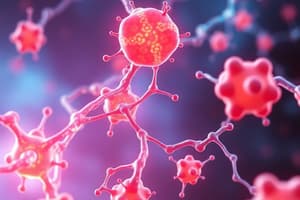Podcast
Questions and Answers
What is the primary mechanism of action of sympathomimetic drugs?
What is the primary mechanism of action of sympathomimetic drugs?
- Blocking the release of norepinephrine
- Stimulating the release of acetylcholine
- Inhibiting the parasympathetic nervous system
- Binding to alpha and beta adrenergic receptors (correct)
What is the effect of sympathomimetic drugs on heart rate?
What is the effect of sympathomimetic drugs on heart rate?
- Increase heart rate (correct)
- Decrease heart rate
- Irregularly change heart rate
- Have no effect on heart rate
Which type of sympathomimetic drug is used to treat bronchospasm and asthma?
Which type of sympathomimetic drug is used to treat bronchospasm and asthma?
- Beta-2 agonists (correct)
- Mixed agonists
- Alpha-1 agonists
- Beta-1 agonists
What is a common clinical use of sympathomimetic drugs?
What is a common clinical use of sympathomimetic drugs?
What is a potential adverse effect of sympathomimetic drugs on the cardiovascular system?
What is a potential adverse effect of sympathomimetic drugs on the cardiovascular system?
What is a contraindication for the use of sympathomimetic drugs?
What is a contraindication for the use of sympathomimetic drugs?
Which of the following is NOT a type of sympathomimetic drug?
Which of the following is NOT a type of sympathomimetic drug?
What is the effect of sympathomimetic drugs on blood vessels?
What is the effect of sympathomimetic drugs on blood vessels?
What is the effect of sympathomimetic drugs on glucose release?
What is the effect of sympathomimetic drugs on glucose release?
What is the primary neurotransmitter involved in the 'fight or flight' response that is affected by sympathomimetic drugs?
What is the primary neurotransmitter involved in the 'fight or flight' response that is affected by sympathomimetic drugs?
Flashcards are hidden until you start studying
Study Notes
Sympathomimetic Drugs
Sympathomimetic drugs, also known as adrenergic drugs, are a class of medications that mimic the effects of the sympathetic nervous system.
Mechanism of Action
- Bind to alpha and beta adrenergic receptors, stimulating the sympathetic nervous system
- Increase the levels of norepinephrine, a neurotransmitter involved in the "fight or flight" response
Effects
- Increase heart rate and blood pressure
- Increase cardiac output and contractility
- Vasoconstriction (narrowing of blood vessels)
- Increase glucose release from energy stores
- Increase energy and alertness
- Bronchodilation (relaxation of airway muscles)
Types of Sympathomimetic Drugs
- Alpha-1 agonists: Increase blood pressure, vasoconstriction, and pupil dilation
- Examples: phenylephrine, midodrine
- Alpha-2 agonists: Decrease blood pressure, decrease sympathetic outflow
- Examples: clonidine, methyldopa
- Beta-1 agonists: Increase heart rate and contractility
- Examples: dobutamine, isoproterenol
- Beta-2 agonists: Bronchodilation, relaxation of airway muscles
- Examples: salmeterol, formoterol
- Mixed agonists: Combination of alpha and beta effects
- Examples: epinephrine, norepinephrine
Clinical Uses
- Cardiovascular: Increase blood pressure in hypotensive patients, treat heart failure
- Respiratory: Treat bronchospasm and asthma
- Anesthesia: Increase blood pressure during anesthesia
- Ophthalmic: Treat glaucoma and pupil dilation
Adverse Effects
- Cardiovascular: Increased heart rate, blood pressure, and cardiac workload
- Central nervous system: Anxiety, tremors, and insomnia
- Respiratory: Tachypnea (rapid breathing) and bronchospasm
Contraindications
- Hypertension: Avoid using sympathomimetic drugs in patients with uncontrolled hypertension
- Cardiac disease: Avoid using sympathomimetic drugs in patients with cardiac disease or arrhythmias
- Pregnancy: Use with caution in pregnant patients due to potential effects on fetal heart rate and blood pressure
Sympathomimetic Drugs
Mechanism of Action
- Bind to alpha and beta adrenergic receptors, stimulating the sympathetic nervous system
- Increase levels of norepinephrine, a neurotransmitter involved in the "fight or flight" response
Effects
- Increase heart rate and blood pressure
- Increase cardiac output and contractility
- Cause vasoconstriction (narrowing of blood vessels)
- Increase glucose release from energy stores
- Increase energy and alertness
- Cause bronchodilation (relaxation of airway muscles)
Types of Sympathomimetic Drugs
Alpha-1 Agonists
- Increase blood pressure, vasoconstriction, and pupil dilation
- Examples: phenylephrine, midodrine
Alpha-2 Agonists
- Decrease blood pressure, decrease sympathetic outflow
- Examples: clonidine, methyldopa
Beta-1 Agonists
- Increase heart rate and contractility
- Examples: dobutamine, isoproterenol
Beta-2 Agonists
- Cause bronchodilation, relaxation of airway muscles
- Examples: salmeterol, formoterol
Mixed Agonists
- Combination of alpha and beta effects
- Examples: epinephrine, norepinephrine
Clinical Uses
- Cardiovascular: increase blood pressure in hypotensive patients, treat heart failure
- Respiratory: treat bronchospasm and asthma
- Anesthesia: increase blood pressure during anesthesia
- Ophthalmic: treat glaucoma and pupil dilation
Adverse Effects
- Cardiovascular: increased heart rate, blood pressure, and cardiac workload
- Central nervous system: anxiety, tremors, and insomnia
- Respiratory: tachypnea (rapid breathing) and bronchospasm
Contraindications
- Hypertension: avoid using sympathomimetic drugs in patients with uncontrolled hypertension
- Cardiac disease: avoid using sympathomimetic drugs in patients with cardiac disease or arrhythmias
- Pregnancy: use with caution in pregnant patients due to potential effects on fetal heart rate and blood pressure
Studying That Suits You
Use AI to generate personalized quizzes and flashcards to suit your learning preferences.





